Understanding Ptosis: Causes and Treatments in Adults
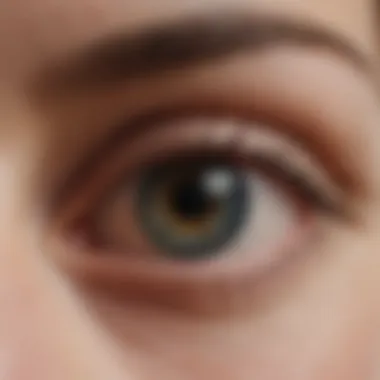
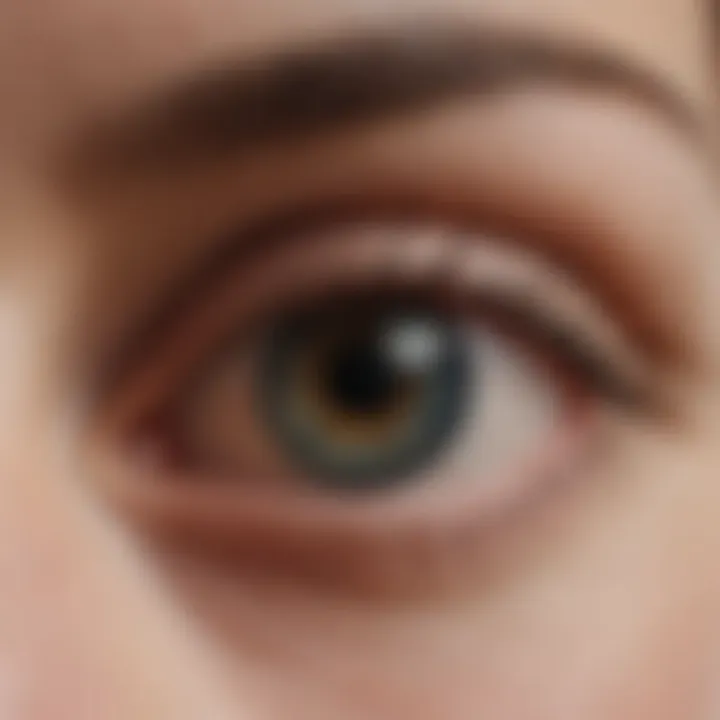
Intro
Ptosis, a condition characterized by the drooping of one or both eyelids, can occur in adults due to various underlying causes. This article aims to demystify the complexity of ptosis by providing an understanding of its root causes. Factors like neurological issues, muscular problems, and environmental influences contribute to this condition. Moreover, a comprehensive overview of diagnostic methods and treatment alternatives will be discussed.
Understanding the intricacies of ptosis is essential for both medical professionals and patients. It is crucial to discern not just the symptoms, but also the underlying mechanisms driving the condition. This knowledge can enable timely intervention and potentially modify the impact of ptosis on an individual’s health and quality of life.
Recent Advances
Latest Discoveries
Recent research has revealed significant insights into the neurological pipelines that can lead to ptosis. Neurologists identify conditions such as Horner's syndrome and myasthenia gravis as notable contributors. Innovations in imaging technology allow healthcare providers to visualize these conditions with better clarity than ever before. This improved understanding enhances diagnosis accuracy and informs treatment strategies more effectively.
Technological Innovations
The advent of minimally invasive surgical techniques represents a major leap in ptosis treatment. Surgeons now utilize advanced tools and techniques to correct eyelid drooping without the need for extensive recovery time. For instance, advancements in robotic-assisted surgeries provide precision that traditional methods lack. Such innovations cater to patient comfort while ensuring favorable outcomes.
Understanding Ptosis Causes
The etiology of ptosis is diverse, encompassing a spectrum of medical conditions and environmental factors. It is valuable to identify these causes early on for effective management.
- Neurological Factors: Conditions like nerve damage or neurological disorders can inhibit eyelid muscle control. For instance, third cranial nerve palsy leads to significant eyelid drooping.
- Muscular Factors: Myogenic causes, such as myasthenia gravis, directly affect the muscle's ability to function correctly. Weakness in the levator muscle results in ptosis.
- Environmental Influences: External factors, including traumatic injuries or chronic environmental stressors, may also precipitate this condition. Prolonged exposure to harsh elements can contribute to eyelid degeneration over time.
Methodology
Research Design
A multi-faceted research approach is vital in unraveling the causes behind ptosis. Studies often involve a cross-sectional design to assess various populations, from those diagnosed with ptosis to healthy control groups. This design allows for comparative analyses and highlights significant correlations.
Data Collection Techniques
Surveys and clinical assessments are essential in collecting data regarding ptosis. Medical histories, symptom questionnaires, and diagnostic tests like electromyography (EMG) help determine underlying causes effectively. Gathering qualitative and quantitative data promotes a thorough understanding of ptosis and its diverse ramifications.
Understanding ptosis is not just about recognizing a physical symptom; it involves a deep exploration into the factors that impair daily functioning and overall well-being.
The dialogue surrounding ptosis must include all potential causes, treatment options, and the implications of delayed intervention. Armed with this information, readers can appreciate the importance of seeking timely medical advice to address their concerns. The ongoing quest to uncover the mysteries of ptosis will only serve to enhance patient outcomes and foster a better comprehension of this condition.
Definition of Ptosis
Ptosis refers to the drooping or falling of the upper eyelid. This condition can affect one or both eyelids and may be a result of various underlying causes that require thorough understanding. Awareness of ptosis is crucial not only for diagnosis but also for appropriate treatment interventions. The significance of this term is underscored by its implications for one’s well-being, as it can impact vision and aesthetics.
Clinical Overview
In clinical settings, ptosis is often categorized based on its cause and the presence of accompanying symptoms. The condition itself can lead to obstructed vision, as the eyelid does not fully retract during eye opening. Patients with ptosis might exhibit compensatory behaviors, such as raising their eyebrows or tilting their head back to improve visibility. These adaptations can put additional strain on surrounding muscles over time.
Types of Ptosis
Understanding the different types of ptosis is essential for determining the appropriate management strategy. There are two primary categories: congenital and acquired ptosis.
Congenital Ptosis
Congenital ptosis occurs when a child is born with the condition. It results from improper development of the levator muscle, the tissue responsible for lifting the eyelid. This condition can vary in severity, impacting the visual development of affected children. The primary characteristic of congenital ptosis is its early onset, often noticeable shortly after birth.
Congenital ptosis can lead to significant issues if not treated, including amblyopia, or lazy eye, due to the constant obstruction of vision. Early diagnosis and intervention are crucial in managing this type of ptosis, making it a particularly relevant focus in this article.
Acquired Ptosis
Acquired ptosis develops later in life and may arise due to various factors, such as neurological damage, muscular weakness, or aging. A hallmark of acquired ptosis is its often sudden onset, and patients may report changes in eyelid position over time. Factors contributing to acquired ptosis might include an underlying neurological disorder, such as myasthenia gravis or oculomotor nerve palsy, and trauma to the eyelid.
The unique feature of acquired ptosis is its potential connection to systemic health conditions, highlighting the importance of comprehensive evaluations in adult patients. Understanding both types of ptosis is necessary for creating effective treatment plans tailored to individual cases, enhancing patient quality of life.
Anatomy of Eyelid Structure
Understanding the anatomy of the eyelid is crucial in comprehending the underlying causes of ptosis. The eyelids serve multiple important functions, including protecting the eye from debris, regulating the amount of light entering the eye, and facilitating tear distribution. Anomalies in the eyelid structure can significantly affect their functionality and, consequently, the overall health of the eye. This section will delve into the muscle composition and nerve supply of the eyelid, which are key factors in the development of ptosis.
Muscle Composition
The eyelids are primarily controlled by muscles and tendons that enable them to open and close. The levator palpebrae superioris muscle plays a pivotal role in elevating the upper eyelid. A malfunction or weakening of this specific muscle is often associated with acquired ptosis. The orbicularis oculi, the muscle surrounding the eyelids, contributes to closing them and is also important in blinking. Adequately functioning muscles ensure that the eyelids move smoothly and effectively.
Several conditions can affect these muscles. For instance, age-related changes may lead to atrophy of the levator muscle or its aponeurosis. Similarly, conditions such as myasthenia gravis can impair muscle function, causing transient or permanent eyelid drooping. Older adults especially may experience a weakening of these muscles due to prolonged use over time, contributing to the higher prevalence of ptosis seen in this demographic. In addition, rare congenital muscle disorders might also result in ptosis from birth.
Nerve Supply
The nerve supply to the eyelids is equally significant in the context of ptosis. The oculomotor nerve, specifically its third cranial nerve component, is responsible for the motor function of the levator palpebrae superioris muscle. Damage to this nerve can result in ptosis due to the loss of motor control. Other cranial nerves also play a role in eyelid function by influencing facial muscle coordination and sensory feedback, which are essential for the proper functioning of the eye and eyelids.
A reduction in nerve function can be seen in various neurological conditions, including strokes or tumors pressing on these nerves. Understanding these pathways is vital in diagnosing the specific type of ptosis presented in patients. Thus, a thorough evaluation of the eyelid's anatomy, both muscular and nervous, can provide critical insights into the origin and management of ptosis.
"A comprehensive understanding of eyelid structure is essential for recognizing the complex mechanisms that lead to conditions such as ptosis."
Analyzing the anatomy of the eyelid forms the foundation for further exploration into the causes of ptosis, whether they stem from neurological, muscular, or other systemic influences.
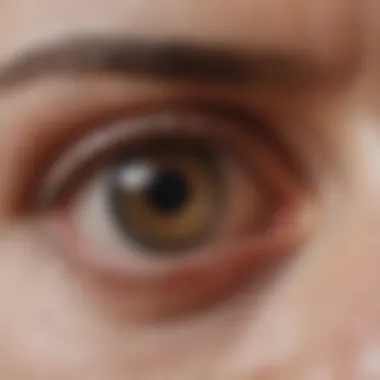
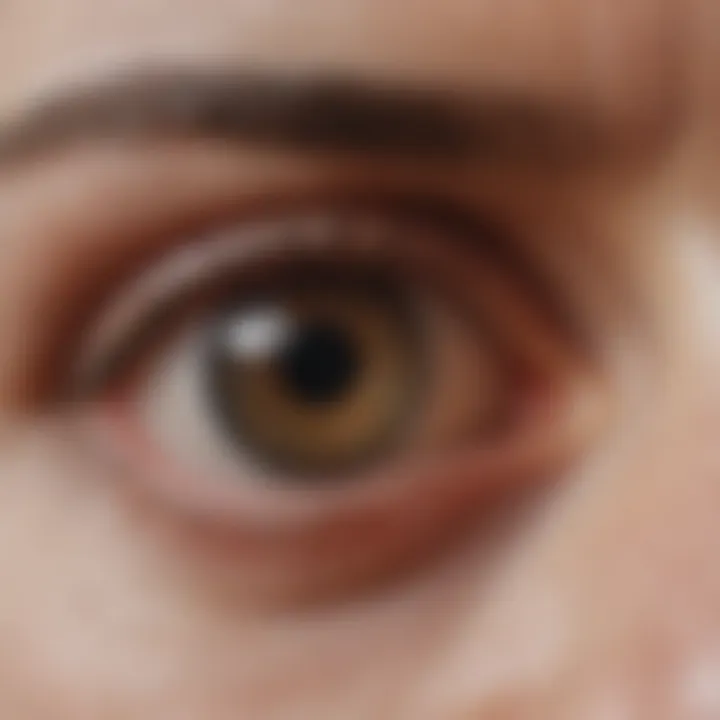
Neurological Causes of Ptosis
The topic of neurological causes of ptosis is crucial in understanding the underlying mechanisms that contribute to this eye condition. Ptosis, characterized by the drooping of the upper eyelid, can have various origins, amongst which neurological factors play a significant role. Neurological issues, such as cranial nerve palsies, can lead to the dysfunction of the muscles responsible for eyelid elevation. Understanding these causes is essential for accurate diagnosis and management, allowing healthcare professionals to provide effective treatment plans tailored to the patient's specific condition.
Cranial Nerve Palsy
Cranial nerve palsy refers to the impairment of any of the twelve cranial nerves that can result in ptosis. The most notable among these nerves is the oculomotor nerve, which innervates the levator palpebrae superioris muscle, primarily responsible for raising the upper eyelid.
Oculomotor Nerve Damage
Oculomotor nerve damage is a key contributor to ptosis. Damage to this nerve can lead to the complete inability to lift the eyelid or cause significant drooping. A characteristic feature of oculomotor nerve damage is the immediate and noticeable change in eyelid position, often accompanied by other symptoms such as double vision or pupil irregularities.
This aspect is particularly relevant for this article because it highlights a common cause of ptosis that can arise due to various reasons, including trauma, aneurysms, or tumors. Oculomotor nerve damage provides a focal point for understanding the intricate relationship between neurological function and eyelid mobility. In discussing this, we can emphasize the need for prompt medical evaluation in patients presenting with sudden onset of ptosis, as it could indicate more severe neurological conditions.
While the primary advantage of discussing oculomotor nerve damage is its clear intersection with ptosis, one disadvantage lies in the potential for misdiagnosis, especially if attention is not paid to accompanying symptoms.
Other Cranial Nerves
Apart from the oculomotor nerve, other cranial nerves can also lead to ptosis. For example, the trochlear and abducens nerves can indirectly influence eyelid position through their connections with the ocular muscles. Although they are not primarily responsible for eyelid elevation, their impairment can lead to complex eye movements and contribute to the appearance of ptosis.
The inclusion of other cranial nerves in this discussion broadens the understanding of how various neurological factors can interact. It highlights the interconnectedness of the nervous system and ocular health, making it a valuable point in this article. A potential advantage of this exploration is the comprehensive insight it offers into the condition's multifactorial nature. However, the complexity of these interactions can also be a disadvantage in that it may confuse the straightforward association between nerve damage and ptosis.
Myasthenia Gravis
Myasthenia gravis is an autoimmune disorder that can also lead to ptosis. This condition causes fluctuating muscle weakness, affecting the eyelids distinctly. Patients often experience varying degrees of eyelid drooping throughout the day, which typically worsens with activity and improves with rest. This cyclical nature of symptoms can make diagnosis challenging. Myasthenia gravis emphasizes the importance of identifying underlying systemic issues as a potential cause of ptosis.
Horner's Syndrome
Horner's syndrome is another critical factor in the neurological causes of ptosis. It results from disruption of the sympathetic nerves that supply the eye. The hallmark of Horner’s syndrome includes ptosis, miosis (constricted pupil), and anhydrosis (lack of sweating). Understanding this syndrome is essential, as it signifies an underlying pathology that may need further investigation, such as a tumor or injury to the cervical sympathetic pathway.
Overall, the exploration of neurological causes of ptosis brings insight into how intricate human anatomy and physiology are interconnected. Understanding these causes will ultimately aid in better diagnosis and treatment for affected individuals.
Muscular Causes of Ptosis
Muscular causes of ptosis are significant in understanding how various factors influence the positioning of the eyelid. The eyelid's ability to lift involves complex muscle connections and functionality. If these muscles weaken or become compromised, ptosis can result. Understanding muscular causes is crucial not just for diagnosis but also for proper treatment.
Aponeurotic Ptosis
Aponeurotic ptosis is primarily linked to the dysfunction of the levator muscle aponeurosis. This condition often arises from age-related changes or other factors that weaken the connection between the muscle and the eyelid itself. Patients with aponeurotic ptosis typically present with a noticeable drooping of the upper eyelid, which may lead to visual obstruction.
The age-related process can gradually affect this muscle's tensile strength, forming a prominent clinical presentation. It is important to assess the eyelid position carefully and often should be distinguished from other forms of ptosis. In some cases, prolonged contact lens wear or previous eye surgeries can also induce aponeurotic ptosis. Treatment options may include surgical procedures aimed at tightening the aponeurosis to restore proper eyelid function.
Age-related Changes
Age-related changes play a critical role in the development of ptosis. As individuals age, the support structures, including muscles and ligaments that keep the eyelids elevated, may weaken. This degradation can impact eyelid mobility and function.
Typically, the fatty tissue around the eyelid may also change, leading to skin laxity and drooping. The impact of aging is often compounded by other health issues, making assessment and intervention crucial. Surgical options exist to remove excessive skin and tighten the surrounding tissues, offering functional and aesthetic improvement.
Understanding these muscular causes can enhance awareness and facilitate timely interventions. Regular evaluations for older adults are beneficial for identifying these changes early, allowing for appropriate treatment options.
Systemic Conditions Linked to Ptosis
Systemic conditions can significantly impact the occurrence and severity of ptosis in adults. Understanding these links is crucial for a complete view of the factors that contribute to this eyelid condition. Systemic diseases can alter nerve function and muscle strength, which doesn’t just play a role in ptosis, but also informs effective treatment strategies and the management of the symptoms. By evaluating systemic conditions, one can gain insights into how widespread health issues manifest in localized symptoms like ptosis.
Diabetes Mellitus
Impact on Nerve Function
Diabetes mellitus is known for its wide-ranging effects on the body, particularly in relation to nerve health. Neuropathy, often seen in diabetic patients, can affect the cranial nerves responsible for eyelid function. The dysfunction of these nerves can lead to muscle weakness, resulting in ptosis. This relationship is crucial as it guides both diagnosis and treatment options for individuals suffering from this disorder.
The unique feature of diabetic neuropathy is its gradual development, which often goes unnoticed until symptoms manifest. Importantly, recognizing the neurologic impact of diabetes allows doctors to intervene earlier. For instance, controlling blood sugar levels can help minimize nerve damage and, potentially, ptosis-related symptoms.
In the context of this article, understanding the connection between diabetes and ptosis adds depth to the analysis of systemic health issues. Effective management of diabetes can enhance quality of life and potentially stabilize or reduce the severity of ptosis in affected individuals.
Thyroid Disorders
Thyroid disorders, such as Graves' disease or hypothyroidism, can also lead to ptosis. The imbalance in thyroid hormones can disrupt normal muscle activity, particularly involving the eyelids. Patients with hyperthyroidism might experience muscle weakness or inflammation that contributes to drooping eyelids. Conversely, hypothyroid patients can also develop ptosis due to altered muscle tone and strength.
By clarifying the links to thyroid function, this article highlights a critical perspective in understanding ptosis. Monitoring thyroid health and ensuring proper hormone balance become essential parts of the ptosis evaluation process. Addressing thyroid issues may not only alleviate ptosis but also improve overall health.
The management of systemic conditions is vital for those experiencing ptosis, as they may contribute significantly to both the diagnosis and treatment pathways.
In summary, systemic conditions like diabetes and thyroid disorders should not be overlooked when assessing ptosis. Their effects on nerve and muscle function provide valuable context for understanding this condition. Addressing these health issues can lead to better outcomes for patients and reduce the burden of ptosis on their quality of life.
Trauma as a Contributing Factor
Trauma plays a significant role in the development of ptosis in adults. Understanding this link is crucial for grasping how physical injuries can affect eyelid function. In this section, we will detail how various types of trauma, from direct injuries to surgical procedures, can lead to changes in eyelid position.
Direct Injury to the Eyelid
Direct injury to the eyelid is a common cause of ptosis. This can occur from accidents, falls, or even physical altercations. When the eyelid sustains injury, the muscles and surrounding structures can be damaged, leading to a failure of the eyelid to lift properly.


The extent of ptosis may vary based on the severity of the injury. For example, a minor scratch may cause temporary drooping, while a significant laceration can damage the levator muscles directly, resulting in more severe and persistent ptosis.
Some typical signs of trauma-induced ptosis include:
- Swelling: Injured eyelids often swell, impacting their function.
- Bruising: Ecchymosis around the eyelid can suggest internal injuries.
- Loss of Control: Difficulty in eyelid movement can indicate muscle or nerve damage.
Accurate assessment is crucial in cases of trauma. A thorough examination can help determine whether ptosis is temporary or if surgical intervention is needed.
Surgical Interventions
Surgical interventions are another avenue through which trauma may contribute to ptosis. In some cases, surgical procedures designed to address other eye conditions can inadvertently lead to eyelid drooping.
For example, during cataract surgery or other ocular surgeries, manipulation of the eyelid or surrounding structures may result in weakening of the muscles controlling eyelid elevation.
Also, surgeries that aim to correct ptosis can sometimes lead to over correction or under correction, which can further complicate eyelid position. It's important for medical professionals to be aware of these potential outcomes.
Understanding the underlying factors contributing to ptosis can aid in more effective treatment and management strategies.
Researchers and practitioners must remain vigilant about the potential for trauma to induce ptosis. This awareness encourages timely interventions and better outcomes for affected individuals.
Environmental Factors
Environmental factors significantly contribute to the understanding of ptosis in adults. These factors can influence both the onset and progression of the condition. Recognizing these elements is crucial for developing effective treatment plans and for the prevention of ptosis.
Allergenic Reactions
Allergenic reactions may trigger inflammation and irritation around the eyelids, leading to temporary or permanent ptosis. Common allergens include pollen, dust mites, animal dander, and certain cosmetic products. When individuals are exposed to these allergens, the immune response can cause swelling and drooping of the eyelid.
In cases of severe allergic reactions, such as anaphylaxis, the eyelids may also droop due to systemic effects. Individuals with a personal or family history of allergies should monitor symptoms carefully. Managing allergens through avoidance or antihistamines may help reduce the risk of ptosis. Moreover, recognizing the signs of an allergic reaction early can prevent complications.
Chronic Eye Conditions
Chronic eye conditions can lead to ptosis as well. Conditions such as conjunctivitis, blepharitis, and keratitis often create discomfort and may affect muscle performance around the eyelids. For instance, chronic inflammation from blepharitis can weaken eyelid muscles over time, contributing to the development of ptosis.
Regular eye examinations are essential for individuals with chronic eye issues to monitor any changes in eyelid position and function. Appropriate management strategies, including medication or lifestyle modifications, are necessary to alleviate symptoms and potentially prevent further deterioration of eyelid strength.
Understanding the role of environmental factors in cases of ptosis can lead to better diagnosis and treatment outcomes.
Diagnostic Approaches
Diagnostic approaches are critical to understanding the underlying causes of ptosis in adults. A thorough evaluation leads to accurate diagnosis and appropriate treatment. It involves a combination of clinical assessments, advanced imaging techniques, and specialized studies to identify any nerve or muscular dysfunction.
Clinical Evaluation
The clinical evaluation is the first step in diagnosing ptosis. It includes a detailed patient history and a physical examination. Physicians look for various factors, such as the age of onset, the presence of other symptoms, and any history of trauma or systemic diseases. During the physical examination, doctors assess the degree of ptosis, eye movement, and the function of surrounding muscles.
Assessing the symmetry of eyelids can provide valuable insights into whether the ptosis is unilateral or bilateral. The patient's ability to lift the eyelids voluntarily can indicate the muscle's health. This evaluation sets the foundation for further diagnostic measures, helping to pinpoint specific causes of the condition.
Imaging Techniques
Advanced imaging techniques play a significant role in diagnosing ptosis. They provide detailed visualizations of anatomical structures, allowing for a better understanding of underlying issues.
MRI
Magnetic Resonance Imaging (MRI) is particularly useful in evaluating both soft tissues and nerves involved in eyelid function. A key characteristic of MRI is its ability to produce high-resolution images without exposing patients to ionizing radiation. This makes it a beneficial choice for examining potentially intricate structures in the head and neck region.
MRI is especially effective in detecting lesions or tumors that may compress nerves, leading to ptosis. A unique feature of MRI is its capacity to differentiate between various tissue types, thus assisting in diagnosing conditions like myasthenia gravis or cranial nerve palsies. However, MRI can be expensive and may require patients to lie still for extended periods, which could be a disadvantage for some individuals.
CT Scans
Computed Tomography (CT Scans) offers another approach to visualizing the delicate anatomy associated with ptosis. A key characteristic of CT scans is their speed and availability in most medical facilities, making them a popular choice for urgent assessments.
CT scans excel in providing clear images of bony structures and can be particularly useful if trauma is suspected. A unique feature of CT imaging is its ability to quickly highlight any fractures or abnormalities in the orbital area. However, one must consider that CT scans involve exposure to radiation, which could be a limitation, especially for younger patients.
Electrodiagnostic Studies
Electrodiagnostic studies are important for understanding the electrical activity in muscles and nerves related to eyelid function. These tests help identify any neuromuscular disorders that may contribute to ptosis. Through methods like electromyography (EMG), doctors can assess the health of muscle and nerve tissues. This approach provides crucial information on whether the ptosis is due to muscular weakness or nerve impairment.
Management and Treatment Options
The management and treatment of ptosis are crucial components in addressing the underlying causes of the condition. Understanding the options available allows patients and healthcare providers to make informed decisions that enhance both functional and aesthetic outcomes. Addressing ptosis effectively can lead to improved vision and quality of life. Treatment options vary based on individual circumstances such as the etiology of ptosis, severity, and patient preferences.
Surgical Interventions
Surgical intervention is often the most effective method to correct ptosis. It aims to enhance eyelid function and appearance, depending on the specific type of ptosis.
Levator Muscle Resection
The levator muscle resection is a surgical technique that involves shortening the levator muscle, which is primarily responsible for lifting the eyelid. This procedure provides a more reliable and stable eyelid position post-operatively. The key characteristic of this approach is its focus on directly altering the muscle's length, allowing for a targeted correction that may yield significant improvements in eyelid functionality. Many specialists consider it a beneficial choice due to its effectiveness and relatively straightforward recovery.

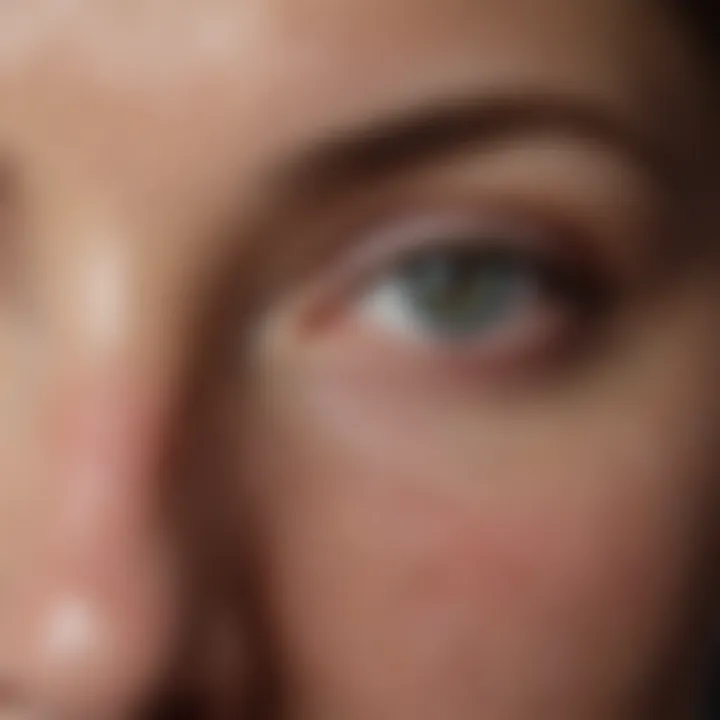
Advantages of Levator Muscle Resection include:
- Improved eyelid height and function
- Increased satisfaction for patients seeking aesthetic correction
Potential disadvantages may comprise:
- Risks associated with any surgical procedure, such as infection or scarring
- Variable outcomes depending on individual healing processes
Frontalis Sling Procedure
The frontalis sling procedure is another surgical option, particularly indicated for patients with severe ptosis where traditional muscle repair may not be suitable. This technique involves creating a connection between the eyelid and the frontalis muscle, enabling the patient to elevate the eyelid by using forehead muscle action. The unique feature of this procedure is its adaptability for cases where the levator muscle function is significantly compromised. It is popular for cases associated with myogenic or neurogenic factors of ptosis.
Advantages of Frontalis Sling Procedure include:
- Effective in cases of weak levator muscle function
- Allows for greater eyelid opening in severe ptosis cases
Disadvantages might include:
- Dependence on the patient’s ability to use the forehead muscle effectively
- Potential cosmetic concerns due to visible scarring or deformity in some cases
Non-surgical Management
While surgery is a commonly pursued option, some patients may prefer or require non-surgical management strategies. These methods focus on monitoring and managing symptoms without invasive procedures.
Medications
Medications can play a role in managing symptoms associated with ptosis, particularly for cases linked to conditions like Myasthenia Gravis. The primary purpose of these medications is to enhance the efficacy of the nerve signals to the eyelid muscles. The unique aspect of medication management is that it allows for treatment without the need for surgery, which could be crucial for patients with medical contraindications for surgery.
Advantages of Medications include:
- Less invasive compared to surgical options
- Ability to treat underlying systemic conditions that may contribute to ptosis
Disadvantages can include:
- Variability in effectiveness among different patients
- Need for ongoing treatment and potential side effects
Lifestyle Adjustments
In conjunction with medical management, lifestyle adjustments can support the overall health of individuals experiencing ptosis. Changes such as proper nutrition, hydration, and adequate sleep can contribute positively. The significant aspect of lifestyle adjustments lies in their overall impact on health and wellness, which helps mitigate factors that may exacerbate ptosis.
Advantages of Lifestyle Adjustments consist of:
- Holistic approach to managing symptoms
- Potential improvement in overall health and quality of life
Disadvantages might incorporate:
- Uncertainty about the direct impact on ptosis severity
- Time and effort required to implement lasting changes
Without a comprehensive understanding of the range of options available, both surgical and non-surgical, it is challenging for patients and healthcare providers to develop an effective management plan tailored to individual needs.
Prognosis and Long-term Outcomes
Understanding the prognosis and long-term outcomes of ptosis in adults is crucial for patients, healthcare providers, and researchers. Ptosis can have a range of implications that extend beyond mere aesthetics. While some patients may experience mild symptoms, others could face significant challenges that affect daily functioning. The prognosis varies based on the underlying cause, duration of the condition, and the effectiveness of treatment interventions.
Potential Complications
Complications arising from ptosis are varied and can affect different areas of a patient's life. If left untreated, severe ptosis can lead to significant visual impairment. The inability to properly close the eyelids may contribute to exposure keratitis, an inflammation of the cornea resulting from dryness. This condition can lead to more severe eye damage if ignored. Furthermore, chronic ptosis may lead to compensatory mechanisms, such as excessive use of the forehead muscles, contributing to tension headaches. The following complications are important to consider:
- Vision problems: Difficulty seeing due to eyelids obstructing the visual field.
- Dry eye syndrome: Increased risk due to inability to fully blink, leading to irritation.
- Psychosocial impacts: Self-image concerns may arise from the appearance, influencing social interactions.
"Prompt diagnosis and appropriate management of ptosis can significantly enhance quality of life, reducing complications that may otherwise arise."
Impact on Quality of Life
The presence of ptosis can significantly affect a person's quality of life. The degree to which an individual is impacted often depends on both the severity of ptosis and its underlying causes. Most patients report psychological distress, self-esteem issues, and feelings of embarrassment. Functional limitations can also occur, particularly if vision is compromised. These demands necessitate a well-rounded approach to treatment, which may involve:
- Surgical options: Many patients seek out surgical correction to improve function and appearance.
- Regular follow-ups: Monitoring the condition helps in managing any associated complications effectively.
- Support networks: Engagement in support groups provides emotional relief.
It is essential to recognize that timely intervention can help mitigate the adverse effects of ptosis on the quality of life. Understanding and addressing these outcomes not only aids in improving a patient's condition but also enriches the overall management of ptosis.
Finale
The conclusion serves as a critical component of this article on ptosis in adults. It ties together the various elements discussed, emphasizing the complexity of the condition. Readers must understand how ptosis can arise from a diverse range of causes, stemming from neurological disorders to muscular issues and environmental influences. This comprehensive perspective allows for better recognition of symptoms and facilitates timely intervention.
Recap of Causes
In summarizing the causes of ptosis, it is clear that the factors are multifaceted. The conditions leading to ptosis can be classified into several categories:
- Neurological Causes: These include cranial nerve palsy, myasthenia gravis, and Horner's syndrome, each affecting eyelid functioning through different mechanisms.
- Muscular Causes: The muscles directly involved may weaken due to aponeurotic ptosis or age-related changes, highlighting how muscle deterioration can impact eyelid position.
- Systemic Conditions: Illnesses such as diabetes and thyroid disorders can have secondary effects on the eyelid.
- Trauma and Surgery: Previous injuries or surgical procedures can lead to functional alterations in the eyelid muscles.
- Environmental Factors: Allergies and chronic eye conditions can also play a part in leading to or exacerbating ptosis.
Incorporating these details not only assists with understanding but also equips individuals with knowledge to seek appropriate medical advice when necessary.
Future Directions for Research
Looking ahead, there are several areas for future research that could significantly enhance our understanding of ptosis and its causes.
- Genetic Studies: Investigating the genetic underpinnings of congenital cases can open new avenues for treatment.
- Treatment Innovations: Exploring new surgical techniques or advances in non-surgical management options could improve patient outcomes.
- Longitudinal Studies: Better understanding of how systemic diseases evolve in relation to ptosis will help predict patient prognosis and tailor interventions.
- Psychosocial Impacts: Researching how ptosis affects the mental health and quality of life of affected individuals may guide multidisciplinary approaches to care.
Understanding the urgent need to address these matters can spur advancements in diagnostic and therapeutic strategies.
Ultimately, this conclusion emphasizes not only the current state of knowledge about ptosis but also the importance of continuous research and awareness on its causes and implications.















